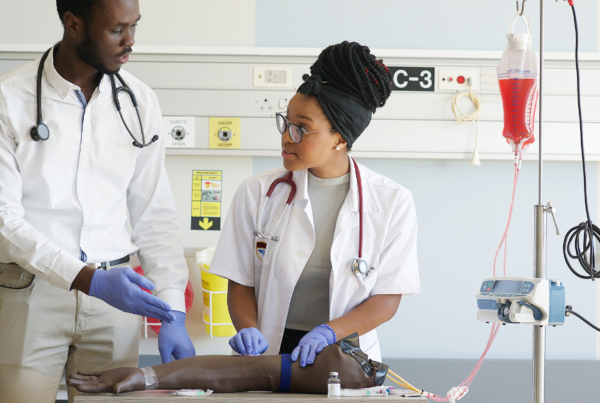When considering a career in phlebotomy, one might wonder about the scope of responsibilities this role entails. A common question that arises is, “Can phlebotomist give injections?” While phlebotomists are highly proficient at drawing blood, the constraints and potential of their job are crucial to grasp for both professionals and patients. This article delves into the responsibilities of a phlebotomist, the regulations surrounding their practice, and what opportunities exist for those looking to expand their skills in the medical field.
| Key Takeaways |
| Phlebotomists are specialized in drawing blood and handling samples, but they are not typically authorized to give injections. |
| Injection administration requires additional training and certification, often outside the scope of a phlebotomist’s duties. |
| Opportunities for career advancement exist for phlebotomists who wish to expand their scope of practice, including roles in nursing, medical assisting, and aesthetic medicine. |
| Phlebotomists interested in giving injections should pursue further education and certification, such as becoming a registered nurse or a medical assistant. |
Understanding the Role of a Phlebotomist
Phlebotomists play a crucial role in healthcare by expertly drawing blood from patients for various medical tests, transfusions, research, or blood donations. These professionals undergo training to care for patients. They ensure that blood collection is safe and as comfortable as possible. Phlebotomists work under the supervision of licensed healthcare providers such as registered nurses, physicians, or lab supervisors, depending on the healthcare setting.
Key Responsibilities of Phlebotomists:
- Patient Interaction: Phlebotomists are often the face of the healthcare facility when it comes to blood draws. They inform patients about the procedure, answer questions, and help alleviate any anxieties patients might have.
- Blood Collection: The primary duty of a phlebotomist is to draw blood samples from patients. This includes locating a suitable vein, preparing the site to minimize infection risk, and performing the venipuncture.
- Sample Handling: After collection, phlebotomists label, store, and transport blood samples to the laboratory for testing. Proper handling is critical to ensure the accuracy of test results.
- Data Entry: Phlebotomists may also be responsible for entering patient information and test orders into electronic health records (EHR) systems.
- Clinical Area Maintenance: Keeping the workspace clean and organized is another important aspect of a phlebotomist’s job, contributing to the overall safety and efficiency of the healthcare environment.
But, despite their training in blood collection, phlebotomists can’t inject. That task requires extra certification and training.
Can phlebotomist give injections? The Regulatory Perspective
The direct answer to the question “Can phlebotomist give injections?” is generally no. Phlebotomists are primarily trained to perform venipunctures, which involve drawing blood from a vein. The training they receive focuses on blood collection techniques, patient interaction, and sample handling rather than on the administration of medications or vaccines via injection.
Why Phlebotomists Are Not Typically Permitted to Give Injections:
- Scope of Practice: The scope of practice for phlebotomists is defined by state laws and healthcare regulations, which typically do not include the administration of injections. This is because giving injections requires knowledge of pharmacology, medication interactions, and patient assessment, skills that are beyond the typical training of a phlebotomist.
- Certification Requirements: In most states, phlebotomists must be certified to perform their duties, but this certification does not include injection training. In contrast, nurses and medical assistants receive comprehensive education in administering injections as part of their training and certification processes.
- Patient Safety: Ensuring patient safety is the primary reason why phlebotomists are not allowed to give injections. The risk of complications, such as adverse reactions or incorrect administration, requires healthcare professionals with the appropriate training to handle these tasks.
But, in some cases, healthcare facilities may allow trained phlebotomists to administer injections. This is rare and requires extra certification.
Exceptions: When Can phlebotomist give injections?
In some cases, trained and certified phlebotomists may give injections. These scenarios are rare and usually occur in specialized settings or under strict supervision.
Specialized Training Programs:
- Intramuscular and Subcutaneous Injections: Some phlebotomists may choose to undergo additional training to learn how to administer intramuscular or subcutaneous injections. This training is often provided through accredited medical training programs and requires passing a certification exam.
- Arterial Blood Collection: While not an injection, phlebotomists with specialized training can draw blood from arteries, a more complex and risk-prone procedure than venous blood draws.
- IV Administration: In some clinical settings, phlebotomists who have received specialized training may assist in setting up and connecting intravenous (IV) drips, although this is typically within the scope of a registered nurse.
Note that, even with more training, phlebotomists can’t give certain injections. This includes anesthetic and cosmetic ones, like Botox®. These tasks are reserved for more highly trained healthcare providers, such as registered nurses or physicians.
Licensing and Training Requirements for Phlebotomists
Phlebotomist licensing and certification requirements vary by state. They usually involve completing an accredited phlebotomy program and passing a certification exam. This method ensures that phlebotomists have the abilities required to execute their duties safely and successfully.
Basic Requirements:
- Education: A high school diploma or equivalent is typically required to enroll in a phlebotomy program. These programs can be completed at community colleges, vocational schools, or through healthcare organizations.
- Certification: After completing the educational program, phlebotomists must pass a certification exam from a recognized certifying body, such as the National Healthcareer Association (NHA) or the American Society for Clinical Pathology (ASCP).
- Continuing Education: Some states need phlebotomists to take continuing education courses. This keeps them up to date on best practices and advancements in the field.
For those looking to expand their role beyond phlebotomy, additional education and certification are necessary. This might involve pursuing a nursing degree or another advanced healthcare role, which includes training in injection administration.
Career Advancement Opportunities: Beyond Phlebotomy
For phlebotomists who are interested in expanding their scope of practice, career advancement opportunities are plentiful. Many healthcare professionals start as phlebotomists and then pursue additional education to become registered nurses, physician assistants, or even doctors.
Pathways for Career Advancement:
- Nursing: Phlebotomists with an interest in injections and direct patient care might consider pursuing a nursing degree. Registered nurses (RNs) undergo training in many medical procedures, such as administering injections. They have a broader scope of practice than phlebotomists.
- Medical Assisting: Another option is to become a medical assistant (MA). This role includes training to give injections, perform tests, and assist in minor surgeries.
- Advanced Practice: For those who aspire to higher-level positions, pursuing education as a physician assistant (PA) or even attending medical school to become a doctor are viable options. These roles allow for a greater range of responsibilities, including diagnosing patients, prescribing medications, and performing complex procedures.
Specialization in Aesthetic Medicine:
- Aesthetic Nursing: Phlebotomists interested in cosmetic procedures, such as Botox® injections, can pursue a career in aesthetic nursing. This path requires becoming a registered nurse and then obtaining additional certification in cosmetic procedures.
- Master Injector Training: RNs who wish to specialize in cosmetic injections can enroll in master injector training programs. These programs focus on the techniques and safety measures needed for administering cosmetic treatments.
FAQs
Can phlebotomist give injections?
No, phlebotomists are not trained or certified to give injections. Their primary role is to draw blood and handle specimens. In rare cases, some may, with extra training, be authorized to inject. But, this is not common.
What is the scope of a phlebotomist’s duties?
Phlebotomists are responsible for drawing blood, preparing samples for testing, and maintaining the cleanliness of their work area. They may also perform data entry and handle patient interactions during the blood draw process.
Can a phlebotomist advance to a role that involves giving injections?
Yes, phlebotomists can study to be a registered nurse, medical assistant, or aesthetic nurse. They would undergo training and certification to administer injections.
Is extra certification essential for phlebotomists to carry out injections?
Yes, a phlebotomist must get more certification and training to give injections. This might involve completing a medical assisting program or obtaining a nursing degree.
Can a phlebotomist administer cosmetic injections like Botox®?
No, phlebotomists are not authorized to administer cosmetic injections. Only a licensed medical professional, like a registered nurse, can perform these procedures. They must train in cosmetic medicine.
Conclusion: Understanding and Respecting the Boundaries of Phlebotomy
Phlebotomists are vital to healthcare. They draw blood and safely handle samples. While the question “Can phlebotomist give injections?” is frequently asked, it’s crucial to remember that the primary goal of phlebotomy is blood collection, not injection administration. Phlebotomists who want to expand their role can advance. There are clear paths for doing so. They need extra training and certification.
For prospective and current phlebotomists, respecting the boundaries of their practice while seeking opportunities for growth is key to a successful and fulfilling career in healthcare. Whether you’re just starting in phlebotomy or considering the next steps in your career, understanding these limitations and possibilities will help guide your professional journey.
Kickstart your healthcare career with Phlebotomy Now School!
Our hands-on training programs will prepare you to excel as a phlebotomist.
Enroll today and begin your path to a rewarding career in healthcare. Start right away!







